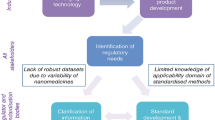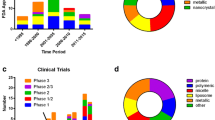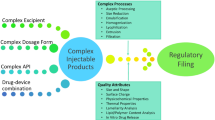Abstract
Ritonavir is an anti-viral compound that has also been employed extensively as a CYP3A4 and P-glycoprotein (Pgp) inhibitor to boost the pharmacokinetic performance of compounds that undergo first pass metabolism. For use in combination products, there is a desire to minimize the mass contribution of the ritonavir system to reduce patient pill burden in these combination products. In this study, KinetiSol® processing was utilized to produce an amorphous solid dispersion of ritonavir at two times the drug load of the commercially available form of ritonavir, and the composition was subsequently developed into a tablet dosage form. The amorphous intermediate was demonstrated to be amorphous by X-ray powder diffraction and 13C solid-state nuclear magnetic resonance and an intimately mixed single-phase system by modulated differential scanning calorimetry and 1H T1/1H T1ρ solid-state nuclear magnetic resonance relaxation. In vitro transmembrane flux analysis showed similar permeation rates for the KinetiSol-made tablet and the reference tablet dosage form, Norvir®. In vivo pharmacokinetic comparison between the two dosage forms resulted in equivalent exposure with approximately 20% Cmax reduction for the KinetiSol tablet. These performance gains were realized with a concurrent reduction in dosage form mass of 45%.








Similar content being viewed by others
References
Cameron DW, Heath-Chiozzi M, Danner S, Cohen C, Kravcik S, Maurath C, et al. Randomised placebo-controlled trial of ritonavir in advanced HIV-1 disease. Lancet. 1998;351(9102):543–9.
Markowitz M, Saag M, Powderly WG, Hurley AM, Hsu A, Valdes JM, et al. A preliminary study of ritonavir, an inhibitor of HIV-1 protease, to treat HIV-1 infection. N Engl J Med. 1995;333(23):1534–40.
Kageyama M, Namiki H, Fukushima H, Terasaka S, Togawa T, Tanaka A, et al. Effect of chronic administration of ritonavir on function of cytochrome P450 3A and P-glycoprotein in rats. Biol Pharm Bull. 2005;28(1):130–7.
Law D, Schmitt EA, Marsh KC, Everitt EA, Wang W, Fort JJ, et al. Ritonavir–PEG 8000 amorphous solid dispersions: in vitro and in vivo evaluations. J Pharm Sci. 2004;93(3):563–70.
Eagling VA, Back D, Barry M. Differential inhibition of cytochrome P450 isoforms by the protease inhibitors, ritonavir, saquinavir and indinavir. Br J Clin Pharmacol 1997;44(2):190–194.
CYP2C9 CC, CYP2D6 CA. The effect of cytochrome P450 metabolism on drug response, interactions, and adverse effects. Am Fam Physician. 2007;76:391–6.
Merry C, Barry MG, Mulcahy F, Ryan M, Heavey J, Tjia JF, et al. Saquinavir pharmacokinetics alone and in combination with ritonavir in HIV-infected patients. AIDS. 1997;11(4):F29–33.
van Heeswijk RP, Veldkamp AI, Hoetelmans RM, Mulder JW, Schreij G, Hsu A, et al. The steady-state plasma pharmacokinetics of indinavir alone and in combination with a low dose of ritonavir in twice daily dosing regimens in HIV-1-infected individuals. AIDS. 1999;13(14):F95–F9.
Decker CJ, Laitinen LM, Bridson GW, Raybuck SA, Tung RD, Chaturvedi PR. Metabolism of amprenavir in liver microsomes: role of CYP3A4 inhibition for drug interactions. J Pharm Sci. 1998;87(7):803–7.
Crommentuyn K, Kappelhoff B, Mulder J, Mairuhu A, Van Gorp E, Meenhorst P, et al. Population pharmacokinetics of lopinavir in combination with ritonavir in HIV-1-infected patients. Br J Clin Pharmacol. 2005;60(4):378–89.
Andreone P, Colombo MG, Enejosa JV, Koksal I, Ferenci P, Maieron A, et al. ABT-450, ritonavir, ombitasvir, and dasabuvir achieves 97% and 100% sustained virologic response with or without ribavirin in treatment-experienced patients with HCV genotype 1b infection. Gastroenterology. 2014;147(2):359–65. e1.
Brayer SW, Reddy KR. Ritonavir-boosted protease inhibitor based therapy: a new strategy in chronic hepatitis C therapy. Expert Rev Gastroenterol Hepatol. 2015;9(5):547–58.
van Erp NP, Gelderblom H, Karlsson MO, Li J, Zhao M, Ouwerkerk J, et al. Influence of CYP3A4 inhibition on the steady-state pharmacokinetics of imatinib. Clin Cancer Res. 2007;13(24):7394–400.
de Weger V, Stuurman F, Mergui-Roelvink M, Nuijen B, Huitema A, Beijnen J, et al. A phase I dose-escalation trial of bi-daily (BID) weekly oral docetaxel as ModraDoc006 in combination with ritonavir. Ann Oncol. 2016;27(suppl_6)
Miller DA, Keen JM, Brough C, Ellenberger DJ, Cisneros M, Williams RO, et al. Bioavailability enhancement of a BCS IV compound via an amorphous combination product containing ritonavir. J Pharm Pharmacol. 2015;
Rosenberg J, Reinhold U, Liepold B, Berndl G, Breitenbach J, Alani L, et al. (2012) inventors; Abbott Laboratories, assignee. Solid pharmaceutical dosage form. United States patent 8268349. 18.
Berndl G, Rosenberg J, Liepold B, Fastnacht K, Jung T, Roth W, et al., inventors; Abbott Laboratories, assignee. Solid pharmaceutical dosage formulations. United States patent application 11/939,640. 31 Jul 2008.
Ellenberger DJ, Miller DA, Williams RO (2017) Expanding the application and formulation space of amorphous solid dispersions with KinetiSol®: a review. AAPS Pharm Sci Tech (In-Review).
Miller DA, Keen JM, Kucera SU, inventors; DisperSol Technologies, LLC, assignee. Formulations of deferasirox and methods of making the same. United States Pat Appl 15185,888. 2016.
Kohri N, Yamayoshi Y, Xin H, Iseki K, SATO N, TODO S, et al. Improving the oral bioavailability of albendazole in rabbits by the solid dispersion technique. J Pharm Pharmacol. 1999;51(2):159–64.
Miller DA, DiNunzio JC, Yang W, McGinity JW, Williams RO III. Enhanced in vivo absorption of itraconazole via stabilization of supersaturation following acidic-to-neutral pH transition. Drug Dev Ind Pharm. 2008;34(8):890–902.
Beten D, Gelbcke M, Diallo B, Moes A. Interaction between dipyridamole and Eudragit S. Int J Pharm. 1992;88(1–3):31–7.
Ueda K, Higashi K, Yamamoto K, Moribe K. Inhibitory effect of hydroxypropyl methylcellulose acetate succinate on drug recrystallization from a supersaturated solution assessed using nuclear magnetic resonance measurements. Mol Pharm. 2013;10(10):3801–11.
Friesen DT, Shanker R, Crew M, Smithey DT, Curatolo W, Nightingale J. Hydroxypropyl methylcellulose acetate succinate-based spray-dried dispersions: an overview. Mol Pharm. 2008;5(6):1003–19.
DiNunzio JC, Hughey JR, Brough C, Miller DA, Williams RO III, McGinity JW. Production of advanced solid dispersions for enhanced bioavailability of itraconazole using KinetiSol® dispersing. Drug Dev Ind Pharm. 2010;36(9):1064–78.
Curatolo W, Nightingale JA, Herbig SM. Utility of hydroxypropylmethylcellulose acetate succinate (HPMCAS) for initiation and maintenance of drug supersaturation in the GI milieu. Pharm Res. 2009;26(6):1419–31.
LaFountaine JS, Jermain SV, Prasad LK, Brough C, Miller DA, Lubda D, et al. Enabling thermal processing of ritonavir–polyvinyl alcohol amorphous solid dispersions by KinetiSol® dispersing. Eur J Pharm Biopharm. 2016;101:72–81.
Rao RN, Ramachandra B, Vali RM, Raju SS. LC–MS/MS studies of ritonavir and its forced degradation products. J Pharm Biomed Anal. 2010;53(4):833–42.
DiNunzio JC, Brough C, Hughey JR, Miller DA, Williams RO, McGinity JW. Fusion production of solid dispersions containing a heat-sensitive active ingredient by hot melt extrusion and Kinetisol® dispersing. Eur J Pharm Biopharm. 2010;74(2):340–51.
Hughey JR, DiNunzio JC, Bennett RC, Brough C, Miller DA, Ma H, et al. Dissolution enhancement of a drug exhibiting thermal and acidic decomposition characteristics by fusion processing: a comparative study of hot melt extrusion and KinetiSol® dispersing. AAPS PharmSciTech. 2010;11(2):760–74.
Miller DA, Gamba M, Sauer D, Purvis TP, Clemens NT, Williams RO. Evaluation of the USP dissolution test method A for enteric-coated articles by planar laser-induced fluorescence. Int J Pharm. 2007;330(1):61–72.
FDA Guidance. Statistical approaches to establishing bioequivalence. Center for Drug Evaluation and Research United States Food and Drug Administration 2001.
Zhou D, Grant DJ, Zhang GG, Law D, Schmitt EA. A calorimetric investigation of thermodynamic and molecular mobility contributions to the physical stability of two pharmaceutical glasses. J Pharm Sci. 2007;96(1):71–83.
LaFountaine JS, McGinity JW, Williams RO III. Challenges and strategies in thermal processing of amorphous solid dispersions: a review. AAPS PharmSciTech. 2016;17(1):43–55.
Fox TG. Influence of diluent and of copolymer composition on the glass temperature of a polymer system. Bull Am Phs Soc. 1952;1:123.
Brostow W, Chiu R, Kalogeras IM, Vassilikou-Dova A. Prediction of glass transition temperatures: binary blends and copolymers. Mater Lett. 2008;62(17):3152–5.
Ghebremeskel AN, Vemavarapu C, Lodaya M. Use of surfactants as plasticizers in preparing solid dispersions of poorly soluble API: stability testing of selected solid dispersions. Pharm Res. 2006;23(8):1928–36.
Chow T. Molecular interpretation of the glass transition temperature of polymer-diluent systems. Macromolecules. 1980;13(2):362–4.
Hancock BC, Shamblin SL, Zografi G. Molecular mobility of amorphous pharmaceutical solids below their glass transition temperatures. Pharm Res. 1995;12(6):799–806.
Hancock BC. Predicting the crystallization propensity of drug-like molecules. J Pharm Sci. 2017;106(1):28–30.
Baird JA, Van Eerdenbrugh B, Taylor LS. A classification system to assess the crystallization tendency of organic molecules from undercooled melts. J Pharm Sci. 2010;99(9):3787–806.
Song Y, Yang X, Chen X, Nie H, Byrn S, Lubach JW. Investigation of drug–excipient interactions in lapatinib amorphous solid dispersions using solid-state NMR spectroscopy. Mol Pharm. 2015;12(3):857–66.
Sarode AL, Sandhu H, Shah N, Malick W, Zia H. Hot melt extrusion for amorphous solid dispersions: temperature and moisture activated drug–polymer interactions for enhanced stability. Mol Pharm. 2013;10(10):3665–75.
Surana R, Suryanarayanan R. Quantitation of crystallinity in substantially amorphous pharmaceuticals and study of crystallization kinetics by X-ray powder diffractometry. Powder Diffract. 2000;15(1):2–6.
Newman A, Engers D, Bates S, Ivanisevic I, Kelly RC, Zografi G. Characterization of amorphous API: polymer mixtures using X-ray powder diffraction. J Pharm Sci. 2008;97(11):4840–56.
Yuan X, Sperger D, Munson EJ. Investigating miscibility and molecular mobility of nifedipine-PVP amorphous solid dispersions using solid-state NMR spectroscopy. Mol Pharm. 2013;11(1):329–37.
Li Y, Pang H, Guo Z, Lin L, Dong Y, Li G, et al. Interactions between drugs and polymers influencing hot melt extrusion. J Pharm Pharmacol. 2014;66(2):148–66.
Rowe RC, Sheskey PJ, Weller PJ. Handbook of pharmaceutical excipients. 6th ed: Pharmaceutical Press, London; 2009.
Law D, Krill SL, Schmitt EA, Fort JJ, Qiu Y, Wang W, et al. Physicochemical considerations in the preparation of amorphous ritonavir–poly (ethylene glycol) 8000 solid dispersions. J Pharm Sci. 2001;90(8):1015–25.
Brettmann B, Bell E, Myerson A, Trout B. Solid-state NMR characterization of high-loading solid solutions of API and excipients formed by electrospinning. J Pharm Sci. 2012;101(4):1538–45.
Hughey JR, Keen JM, Brough C, Saeger S, McGinity JW. Thermal processing of a poorly water-soluble drug substance exhibiting a high melting point: the utility of KinetiSol® dispersing. Int J Pharm. 2011;419(1):222–30.
Bevernage J, Brouwers J, Brewster ME, Augustijns P. Evaluation of gastrointestinal drug supersaturation and precipitation: strategies and issues. Int J Pharm. 2013;453(1):25–35.
Tho I, Liepold B, Rosenberg J, Maegerlein M, Brandl M, Fricker G. Formation of nano/micro-dispersions with improved dissolution properties upon dispersion of ritonavir melt extrudate in aqueous media. Eur J Pharm Sci. 2010;40(1):25–32.
Frank KJ, Locher K, Zecevic DE, Fleth J, Wagner KG. In vivo predictive mini-scale dissolution for weak bases: advantages of pH-shift in combination with an absorptive compartment. Eur J Pharm Sci. 2014;61:32–9.
Heigoldt U, Sommer F, Daniels R, Wagner K-G. Predicting in vivo absorption behavior of oral modified release dosage forms containing pH-dependent poorly soluble drugs using a novel pH-adjusted biphasic in vitro dissolution test. Eur J Pharm Biopharm. 2010;76(1):105–11.
Vangani S, Li X, Zhou P, Del-Barrio M-A, Chiu R, Cauchon N, et al. Dissolution of poorly water-soluble drugs in biphasic media using USP 4 and fiber optic system. Clin Res Regul Aff. 2009;26(1–2):8–19.
Thiry J, Broze G, Pestieau A, Tatton AS, Baumans F, Damblon C, et al. Investigation of a suitable in vitro dissolution test for itraconazole-based solid dispersions. Eur J Pharm Sci. 2016;85:94–105.
Phillips DJ, Pygall SR, Cooper VB, Mann JC. Overcoming sink limitations in dissolution testing: a review of traditional methods and the potential utility of biphasic systems. J Pharm Pharmacol. 2012;64(11):1549–59.
Sarode AL, Wang P, Obara S, Worthen DR. Supersaturation, nucleation, and crystal growth during single- and biphasic dissolution of amorphous solid dispersions: polymer effects and implications for oral bioavailability enhancement of poorly water soluble drugs. Eur J Pharm Biopharm. 2014;86(3):351–60.
Stewart AM, Grass ME, Brodeur TJ, Goodwin AK, Morgen MM, Friesen DT, et al. Impact of drug-rich colloids of Itraconazole and HPMCAS on membrane flux in vitro and oral bioavailability in rats. Mol Pharm. 2017;14:2437–49.
Shi Y, Gao P, Gong Y, Ping H. Application of a biphasic test for characterization of in vitro drug release of immediate release formulations of celecoxib and its relevance to in vivo absorption. Mol Pharm. 2010;7(5):1458–65.
Narang AS, Tang D, Jennings SP, Mathias N, Tsinman KL, Dohoda DJ, et al., inventors; Pion Inc., assignee. Apparatus and method for the assessment of concentration profiling and permeability rates. United States patent application 15/098,514. 20 Oct 2016.
Avdeef A, Bendels S, Di L, Faller B, Kansy M, Sugano K, et al. PAMPA—critical factors for better predictions of absorption. J Pharm Sci. 2007;96(11):2893–909.
Hate SS, Reutzel-Edens SM, Taylor LS. Absorptive dissolution testing of supersaturating systems: impact of absorptive sink conditions on solution phase behavior and mass transport. Mol Pharm. 2017;14:4052–63.
Borbás E, Sinkó Bl, Tsinman O, Tsinman K, Kiserdei Ev, Démuth Bz, et al. Investigation and mathematical description of the real driving force of passive transport of drug molecules from supersaturated solutions. Mol Pharm 2016;13(11):3816–3826.
Sagawa K, Li F, Liese R, Sutton SC. Fed and fasted gastric pH and gastric residence time in conscious beagle dogs. J Pharm Sci. 2009;98(7):2494–500.
Zane P, Guo Z, MacGerorge D, Vicat P, Ollier C. Use of the pentagastrin dog model to explore the food effects on formulations in early drug development. Eur J Pharm Sci. 2014;57:207–13.
Dressman JB. Comparison of canine and human gastrointestinal physiology. Pharm Res. 1986;3(3):123–31.
Akimoto M, Nagahata N, Furuya A, Fukushima K, Higuchi S, Suwa T. Gastric pH profiles of beagle dogs and their use as an alternative to human testing. Eur J Pharm Biopharm. 2000;49(2):99–102.
Zhou R, Moench P, Heran C, Lu X, Mathias N, Faria TN, et al. pH-dependent dissolution in vitro and absorption in vivo of weakly basic drugs: development of a canine model. Pharm Res. 2005;22(2):188–92.
Fancher RM, Zhang H, Sleczka B, Derbin G, Rockar R, Marathe P. Development of a canine model to enable the preclinical assessment of ph-dependent absorption of test compounds. J Pharm Sci. 2011;100(7):2979–88.
Bhattachar SN, Perkins EJ, Tan JS, Burns LJ. Effect of gastric pH on the pharmacokinetics of a BCS class II compound in dogs: utilization of an artificial stomach and duodenum dissolution model and GastroPlus,™ simulations to predict absorption. J Pharm Sci. 2011;100(11):4756–65.
Gatti G, Di Biagio A, Casazza R, De Pascalis C, Bassetti M, Cruciani M, et al. The relationship between ritonavir plasma levels and side-effects: implications for therapeutic drug monitoring. AIDS. 1999;13(15):2083–9.
Haidar SH, Davit B, Chen M-L, Conner D, Lee L, Li QH, et al. Bioequivalence approaches for highly variable drugs and drug products. Pharm Res. 2008;25(1):237–41.
Author information
Authors and Affiliations
Corresponding author
Additional information
Guest Editor: Dave A. Miller
Rights and permissions
About this article
Cite this article
Ellenberger, D.J., Miller, D.A., Kucera, S.U. et al. Generation of a Weakly Acidic Amorphous Solid Dispersion of the Weak Base Ritonavir with Equivalent In Vitro and In Vivo Performance to Norvir Tablet. AAPS PharmSciTech 19, 1985–1997 (2018). https://doi.org/10.1208/s12249-018-1060-x
Received:
Accepted:
Published:
Issue Date:
DOI: https://doi.org/10.1208/s12249-018-1060-x




